International Journal of Image, Graphics and Signal Processing @ijigsp
Статьи журнала - International Journal of Image, Graphics and Signal Processing
Все статьи: 1157
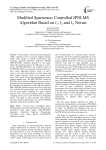
Modified Sparseness Controlled IPNLMS Algorithm Based on l_1, l_2 and l_∞ Norms
Статья научная
In the context of Acoustic Echo Cancellation (AEC), sparseness level of acoustic impulse response (AIR) varies greatly in mobile environments. The modified sparseness-controlled Improved PNLMS (MSC-IPNLMS) algorithm proposed in this paper, exploits the sparseness measure of AIR using l1, l2 and l∞ norms. The MSC-IPNLMS is the modified version of SC-IPNLMS which uses sparseness measure based on l1 and l2 norms. Sparseness measure using l1, l2 and l∞ norms is the good representation of both sparse and dense impulse response, where as the measure which uses l1 and l2 norms is the good representation of sparse impulse response only. The MSC-IPNLMS is based on IPNLMS which allocates adaptation step size gain in proportion to the magnitude of estimated filter weights. By estimating the sparseness of the AIR, the proposed MSC-IPNLMS algorithm assigns the gains for each step size such that the proportionate term of the IPNLMS will be given higher weighting for sparse impulse responses. For a less sparse impulse response, a higher weighting will be given to the NLMS term. Simulation results, with input as white Gaussian noise (WGN), show the improved performance over the SC-IPNLMS algorithm in both sparse and dense AIR.
Бесплатно
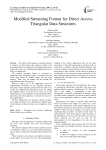
Modified Streaming Format for Direct Access Triangular Data Structures
Статья научная
We define in this paper an extended solution to improve an Out-of-Core data structure which is the streaming format, by adding new information allowing to reduce file access cost, reducing the neighborhood access delay to constant time. The original streaming format is conceived to manipulate huge triangular meshes. It assumes that the whole mesh cannot be loaded entirely into the main memory. That's why the authors did not include the neighborhood in the file structure. However, almost all of the applications need the neighborhood information in the triangular structures. Using the original streaming format does not allow us to extract the neighborhood information easily. By adding the neighbor indices to the file in the same way as the original format, we can benefit from the streaming format, and at the same time, guarantee a constant time access to the neighborhood. We have adapted our new structure so that it can allow us to apply our direct access algorithm to different parts of the structure without having to go through the entire file.
Бесплатно
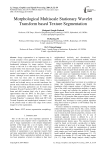
Morphological Multiscale Stationary Wavelet Transform based Texture Segmentation
Статья научная
Image segmentation is an important step in several computer vision applications. The segmentation of images into homogeneous and meaningful regions is a fundamental technique for image analysis. Textures occupy a vital role in a wide range of computer vision research fields; from microscopic images to images sent down to earth by satellites, from the analysis of multi-spectral scan images to outdoor scenes, all consist of texture. Although several methods have been proposed, less work has been done in developing suitable techniques for segmentation of texture images. After a careful and in-depth survey on wavelet transforms, the present study found that efficient numerical solutions in the signal processing applications can be found using Stationary Wavelet Transform (SWT). SWT is redundant, linear and shift invariant, that’s why it gives a better approximation than the DWT. In this paper a novel texture segmentation method based on “SWT and Textural Properties” is proposed. Multi scale SWT with Textural Properties and morphological treatment is used in the present study to detect fine edges from texture images for a fine segmentation.
Бесплатно
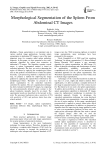
Morphological Segmentation of the Spleen From Abdominal CT Images
Статья научная
Organ segmentation is an important step in various medical image applications. Accurate spleen segmentation in abdominal CT images is one of the most important steps for computer aided spleen pathology diagnosis. In this paper, we have proposed a new semi-automatic algorithm for spleen area extraction in abdominal CT images. The algorithm contains several stages. A spleen segmentation method is based on watershed approach. The first, we seek to determine the region of interest by applying the morphological filters such as the geodesic reconstruction to extract the spleen. Secondly, a pre-processing method is employed. In this step, we propose a method for improving the image gradient by applying the spatial filters followed by the morphological filters. Thereafter we proceed to the spleen segmentation by the watershed transform controlled by markers. The new segmentation technique has been evaluated on different CT images, by comparing the semi-automatically detected spleen contour to the spleen boundaries manually traced by an expert. The experimental results are described in the last part in this work. The automated method provides a sensitivity of 95% with specificity of 99% and performs better than other related methods.
Бесплатно
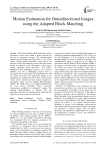
Motion Estimation for Omnidirectional Images using the Adapted Block-Matching
Статья научная
The Block-Matching (BM) method for motion estimation in most video coding is largely discussed in the case of perspective images. The omnidirectional cameras provide images with large field of view. These images contain global information about motion and permit to remove the ambiguity present with little camera motion in perspective case. Nevertheless, these images contain significant radial distortions. The Block-Matching in these catadioptric images is not a resolved problem, and still a challenging research field. A rectangular block representing the neighborhood in BM of a point and used in the perspective images is not appropriate for catadioptric cameras. The work presented in this article concerns the local motion estimation in catadioptric videos with the Adapted Block-Matching (ABM). The ABM based on an adapted neighborhood, the local motion estimation allows successful compensation prediction in catadioptric images. The Adapted Block-Matching is obtained from the equivalence between the omnidirectional image and the projection of scene points on a unit sphere.
Бесплатно
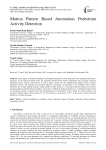
Motion Pattern Based Anomalous Pedestrian Activity Detection
Статья научная
In this paper, an efficient technique for anomalous pedestrian activity detection in the academic institution is proposed. At the pixel and block levels, the proposed method elicits motion components that accurately represent pedestrian action, velocity, and direction, as well as along a frame. We also adopted these motion features to detect anomalous actions. The detection of anomalous behavior in academic environments is not available at the moment. Similarly, the existing method produces a high number of false positives. An anomaly detection dataset and a newly designed proposed student behavior database were used to validate the proposed framework. A significant improvement in anomalous activity recognition has been demonstrated in experimental results. Based on motion features, the proposed method reduces false positives by 3% and increases true positives by 5%. A discussion of future research directions concludes the paper.
Бесплатно
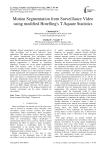
Motion Segmentation from Surveillance Video using modified Hotelling's T-Square Statistics
Статья научная
Motion segmentation is an important task in video surveillance and in many high-level vision applications. This paper proposes two generic methods for motion segmentation from surveillance video sequences captured from different kinds of sensors like aerial, Pan Tilt and Zoom (PTZ), thermal and night vision. Motion segmentation is achieved by employing Hotelling's T-Square test on the spatial neighborhood RGB color intensity values of each pixel in two successive temporal frames. Further, a modified version of Hotelling's T-Square test is also proposed to achieve motion segmentation. On comparison with Hotelling's T-Square test, the result obtained by the modified formula is better with respect to computational time and quality of the output. Experiments along with the qualitative and quantitative comparison with existing method have been carried out on the standard IEEE PETS (2006, 2009 and 2013) and IEEE Change Detection (2014) dataset to demonstrate the efficacy of the proposed method in the dynamic environment and the results obtained are encouraging.
Бесплатно
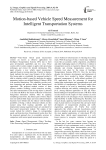
Motion-based vehicle speed measurement for intelligent transportation systems
Статья научная
Video-based vehicle speed measurement systems are known as effective applications for Intelligent Transportation Systems (ITS) due to their great development capabilities and low costs. These systems utilize camera outputs to apply video processing techniques and extract the desired information. This paper presents a new vehicle speed measurement approach based on motion detection. Contrary to feature-based methods that need visual features of the vehicles like license-plate or windshield, the proposed method is able to estimate vehicle’s speed by analyzing its motion parameters inside a pre-defined Region of Interest (ROI) with specified dimensions. This capability provides real-time computing and performs better than feature-based approaches. The proposed method consists of three primary modules including vehicle detection, tracking, and speed measurement. Each moving object is detected as it enters the ROI by the means of Mixture-of-Gaussian background subtraction method. Then by applying morphology transforms, the distinct parts of these objects turn into unified filled shapes and some defined filtration functions leave behind only the objects with the highest possibility of being a vehicle. Detected vehicles are then tracked using blob tracking algorithm and their displacement among sequential frames are calculated for final speed measurement module. The outputs of the system include the vehicle’s image, its corresponding speed, and detection time. Experimental results show that the proposed approach has an acceptable accuracy in comparison with current speed measurement systems.
Бесплатно
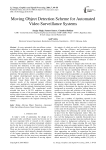
Moving Object Detection Scheme for Automated Video Surveillance Systems
Статья научная
In every automated video surveillance system, moving object detection is an important pre-processing step leading to the extraction of useful information regarding moving objects present in a video scene. Most of the moving object detection algorithms require large memory space for storage of background related information which makes their implementation a difficult task on embedded platforms which are typically constrained by limited resources. Therefore, in order to overcome this limitation, in this paper we present a memory optimized moving object detection scheme for automated video surveillance systems with an objective to facilitate its implementation on standalone embedded platforms. The presented scheme is a modified version of the original clustering-based moving object detection algorithm and has been coded using C/C++ in the Microsoft Visual Studio IDE. The moving object detection results of the proposed memory efficient scheme were qualitatively and quantitatively analyzed and compared with the original clustering-based moving object detection algorithm. The experimental results revealed that there is 58.33% reduction in memory requirements in case of the presented memory efficient moving object detection scheme for storing background related information without any loss in accuracy and robustness as compared to the original clustering based scheme.
Бесплатно
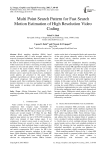
Multi Point Search Pattern for Fast Search Motion Estimation of High Resolution Video Coding
Статья научная
Block matching algorithm (BMA) based motion estimation (ME) is most accepted method for removal of temporal redundancy between frames in video coding. With recent advancement in resolution of video, the need of search pattern covering most of macroblocks within search area in frame is increasing. Existing search patterns are tiny and take plenty of time to reach at edge or corner of the search window. With aim of covering nearly every probable candidate macroblocks in all direction and to speed up the search process, multipoint search patterns are presented in this paper. Initial candidate macroblocks are chosen on grid of 12x12 and then search progresses like traditional diamond or hexagon search. Due to multipoint, chances of trapping in incorrect direction is very less and method can exhibit better quality of encoding with optimum number of search points.
Бесплатно
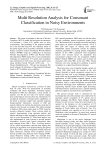
Multi Resolution Analysis for Consonant Classification in Noisy Environments
Статья научная
This paper investigates on the use of Wavelet Transform (WT) to model and recognize the utterances of Consonant – Vowel (CV) speech units in noisy environments. The peculiarity of the proposed method lies in the fact that using WT, non stationary nature of the speech signal can be accurately considered. A hybrid feature extraction namely Normalized Wavelet Hybrid Feature (NWHF) using the combination of Classical Wavelet Decomposition (CWD) and Wavelet Packet Decomposition (WPD) along with z-score normalization technique are studied here. CV speech unit recognition tasks performed for both noisy and clean speech units using Artificial Neural Network (ANN) and k – Nearest Neighborhood (k – NN) are also presented. The result indicates the robustness of the proposed technique based on WT in additive noisy condition.
Бесплатно
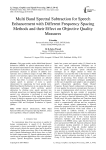
Статья научная
This paper mainly studies Multi Band Spectral Subtraction (MBSS) for speech enhancement based on the spectrum representation in the frequency domain with three different scales(linear, log, mel) and their effect on performance measures in presence of additive non-stationary noise at different ranges of input SNR. Since speech is non-stationary signal, noise distribution is non-uniform i.e few frequency components are affected severely than others. A common method to restore the original speech in presence of noise is speech enhancement by suppressing the back ground noise. Multi Band Spectral Subtraction is one among the speech enhancement techniques which performs spectral subtraction by dividing noisy speech spectrum into uniformly spaced non over lapping frequency bands and spectral over subtraction is performed in each band separately. The performance of this method is evaluated in terms of objective measures such as Cepstrum distance, Log Likelihood Ratio, Weighted Spectral Slope distance, segmental SNR and Perceptual Evaluation of Speech Quality.
Бесплатно
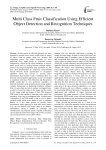
Multi class fruit classification using efficient object detection and recognition techniques
Статья научная
In this paper, an efficient approach has been proposed to localize every clearly visible object or region of object from an image, using less memory and computing power. For object detection we have processed every input image to overcome several complexities, which are the main limitations to achieve better result, such as overlap between multiple objects, noise in the image background, poor resolution etc. We have also implemented an improved Convolutional Neural Network based classification or recognition algorithm which has proved to provide better performance than baseline works. Combining these two detection and recognition approaches, we have developed a competent multi-class Fruit Detection and Recognition (FDR) model that is very proficient regardless of different limitations such as high and poor image quality, complex background or lightening condition, different fruits of same shape and color, multiple overlapped fruits, existence of non-fruit object in the image and the variety in size, shape, angel and feature of fruit. This proposed FDR model is also capable of detecting every single fruit separately from a set of overlapping fruits. Another major contribution of our FDR model is that it is not a dataset oriented model which works better on only a particular dataset as it has been proved to provide better performance while applying on both real world images (e.g., our own dataset) and several states of art datasets. Nevertheless, taking a number of challenges into consideration, our proposed model is capable of detecting and recognizing fruits from image with a better accuracy and average precision rate of about 0.9875.
Бесплатно
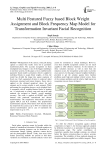
Статья научная
Misalignment of the camera, some jerk during capture is natural that results some tilt or geometric transformed photo. The accurate recognition on these misaligned facial images is one of the biggest challenges in real time systems. In this paper, a fuzzy enabled multi-parameter based model is presented, which is applied to individual blocks to assign block weights. At first, the model has divided the image into square segments of fixed size. Each segmented division is analyzed under directional, structural and texture features. Fuzzy rule is applied on the obtained quantized values for each segment and to assign weights to each segment. While performing the recognition process, each weighted block is compared with all weighted-feature blocks of training set. A weight-ratio to exactly map and one-to-all map methods are assigned to identify overall matching accuracy. The work is applied on FERET and LFW datasets with rotational, translational and skewed transformation. The comparative observations are taken against KPCA and ICA methods. The proportionate transformation specific observations show that the model has improved the accuracy up to 30% for rotational and skewed transformation and in case of translation the improvement is up to 11%.
Бесплатно
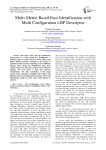
Multi-Metric Based Face Identification with Multi Configuration LBP Descriptor
Статья научная
This paper deals with the performance improvement of a mono modal face identification. A statistical study of various structures of the LBPs (Local Binary Patterns) features associated to two metrics is performed to find out those committing errors on different subjects. Then, during the identification stage, these optimal variants are used, and a simple score level fusion is adopted. The score fusion is done after min-max normalization. The main contribution of this paper consists in the association of multiple LBP schemes with different metrics using simple fusion operation. The overall identification rating up to 99% using AT&T database is achieved.
Бесплатно
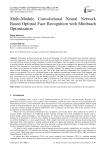
Multi-Module Convolutional Neural Network Based Optimal Face Recognition with Minibatch Optimization
Статья научная
Technology is getting smarter day by day and facilitating every part of human life from automatic alarming, automatic temperature, and personalised choice prediction and behaviour recognition. Such technological advancements are using different machine learning techniques for artificial intelligence. Face recognition is also one of the techniques to develop futuristic artificial intelligence-based technology used to get devices equipped with personalised features and security. Face recognition is also used for keeping information of facial data of employees of any company citizens of any country to get tracked and control over crimes in unfair incidents. For making face recognition more reliable and faster, several techniques are evolving every day. One of the fastest and most dependable face recognitions is CNN based face recognition. This work is designed based on the multiple convolutional module-based CNN equipped with batch normalisation and linear rectified unit for normalising and optimising features with minibatch. Faces in CNN’s fully connected layer are classified using the SoftMax classifier. The ORL and Yale face datasets are used for training. The average accuracy achieved is 94.74% for ORL and 96.60% for Yale Datasets. The convolutional neural network training was done for different training percentages, e.g., 66%, 67%, 68%, 69%, 70%, and 80%. The experimental outcomes exhibited that the defined approach had enhanced the face recognition performance.
Бесплатно
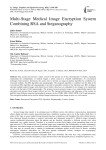
Multi-Stage Medical Image Encryption System Combining RSA and Steganography
Статья научная
Data security has become a major concern in the present era of the communication revolution, especially maintaining the confidentiality of medical images a prime concern in e-health establishments. As conventional techniques hold numerous drawbacks, this study aims to develop an image encryption algorithm by combining two renowned methods: the RSA algorithm and steganography. The proposed algorithm is modified with the help of the conventional RSA algorithm and steganography to provide an attainable solution to this alarming issue. RSA technique encrypts multiple medical images with distinct keys; further, these keys are embedded in two images to be transmitted secretly with the help of LSB steganography. The proposed system generates images of an unidentifiable pattern after encryption and decrypts those images without any loss. The claimed performances and robustness of the system are justified using different numerical and graphical measures such as PSNR, MSE, SSIM, NPCR, UACI, and histograms. This encryption method can be used for medical image transmission where image security is a vital concern.
Бесплатно
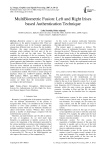
MultiBiometric Fusion: Left and Right Irises based Authentication Technique
Статья научная
Biometric science is one of the important applications in the pattern recognition field. There are several modalities used in the biometric applications, among these different traits we choose the iris modality. Therefore, this paper proposes a multi-biometric technique which combines the both units of the iris modality: the left and the right irises. The fusion combines the advantages of the two instances. For the both units of the iris, the segmentation is realized by a modified method and the feature extraction is done by a global approach (the Daubechies wavelets). The Support Vector Machine SVM is used to obtain scores for fusion. Then the scores obtained are normalized by Min-Max method and the fusion is performed at score level by the combination of two methods: a combination method with a classification method. The Fusion is tested using four databases which are: CASIAV4 database, SDUMLA-HMT database, MMU1, and MMU2 databases. The obtained results have confirmed that the multi-biometric systems are better than the mono-modal systems according to their performance.
Бесплатно
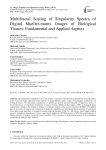
Статья научная
The fundamental component of the work contains a summary of the theoretical foundations of the algorithms of the scale-self-similar approach for the analysis of digital Mueller-matrix images of birefringent architectonics of biological tissues. The theoretical consideration of multifractal analysis and determination of singularity spectra of fractal dimensions of coordinate distributions of matrix elements (Mueller-matrix images - MMI) of biological tissue preparations is based on the method of maxima of amplitude modules of the wavelet transform (WTMM). The applied part of the work is devoted to the comparison of diagnostic capabilities for determining the prescription of mechanical brain injury using algorithms of statistical (central statistical moments of the 1st - 4th orders), fractal (approximating curves to logarithmic dependences of power spectra) and multifractal (WTMM) analysis of MMI linear birefringence of fibrillar networks of neurons of nervous tissue. Excellent (~95%) accuracy of differential diagnosis of the prescription of mechanical injury has been achieved.
Бесплатно
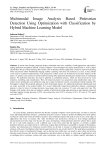
Статья научная
In recent times People commonly display substantial intra-class variability in both appearance and position, making pedestrian recognition difficult. Current computer vision techniques like object identification as well as object classification has given deep learning (DL) models a lot of attention and this application is based on supervised learning, which necessitates labels. Multimodal imaging enables examining more than one molecule at a time, so that cellular events may be examined simultaneously or the progression of these events can be followed in real-time. Purpose of this study is to propose and construct a hybrid machine learning (ML) pedestrian identification model based on multimodal datasets. For pedestrian detection, the input is gathered as multimodal pictures, which are then processed for noise reduction, smoothing, and normalization. Then, the improved picture was categorized using metaheuristic salp cross-modal swarm optimization and optimized using naive spatio kernelized extreme convolutional transfer learning. We thoroughly evaluated the proposed approach on three benchmark datasets for multimodal pedestrian identification that are made accessible to the general public. For several multimodal image-based pedestrian datasets, experimental analysis is done in terms of average precision, log-average miss rate, accuracy, F1 score, and equal error rate. The findings of the studies show that our method is capable of performing cutting-edge detection on open datasets. proposed technique attained average precision of 95%, log-average miss rate of 81%, accuracy of 61%, F1 score of 51%, equal error rate of 59%.
Бесплатно

